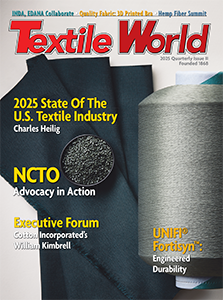ATLANTA — April 6, 2016 — Leading industry experts come together at Texprocess Americas to address the latest in product development, technology, and what the future looks like for the sewn products industry. The Texprocess Americas Symposium is being held May 3-5, 2016, at the Georgia World Congress Center in Atlanta.
Texprocess Americas is co-located with Techtextil North America and JEC Americas. The trifecta of these three shows bring together the full spectrum of technical textiles, nonwovens, sewn products and equipment, technology and composites into one central location.
In addition to the eight symposium sessions offered, three bonus sessions will be available for visitors who have purchased a symposium pass. Those sessions are presented by IAF, Fedustria vzw and a joint session by Techtextil North America, Texprocess Americas and JEC Americas. Visitors can expect to connect with potential new partners, learn about exciting new technologies and discover how they can grow their business while partaking in the Texprocess Americas Symposium.
Texprocess Americas Symposium Sessions:
Automation and Robotics – present and future trends in Product Development
Our industry is dynamically evolving. In manufacturing and through automation, we anticipate reduction in the need to outsource. Processes involving robotics will soon be considered the way to go in advanced product development. Our panelists will discuss, present, challenge and set your hopes and plans straight regarding what’s available, what’s coming and the effect this will have on our industry in the coming years.
Moderator: Yoram Burg, Optitex, USA
Long and Short Term Future of Technology in Apparel
During this session you will learn what brands and retailers need to know, what to look for, and how to choose the right technology for their business. Join the discussion on what the panelists believe their successes and failures have been.
Moderator: Ram Sareen, Tukatech
Creating a Competitive Advantage with an Integrated Cutting Room
An integrated cutting room – which includes marker making, spreading and cutting operations – have a profound impact on a company’s margins. Now the integrated cutting room can be a source for your competitive advantage through the integration of custom equipment, advanced hardware, innovative software, and advanced production systems. The end results are lower cost structures, less errors/mistakes as data is seamlessly transferred between functions instead of being input manually, better quality, and reduced speed to market. Work orders; therefore, are managed more effectively and processed more efficiently allowing for a greater value for your end customer.
Moderator: Dave Gardner, SPESA
Reshoring. Is it for real or still just talk?
Industry leaders from throughout the Sewn Products Supply Chain will participate in a facilitated discussion regarding their company’s Domestic success. Topics discussed will include:
- Current challenges and how to overcome them
- Opportunities within the domestic marketplace
- Profitability
- Importance of supply chain integration
- Role of technology
- Keys for success moving forward
Don’t miss this opportunity to learn how companies are doing more than just talking about Reshoring but are actually making it a strategic part of their business.
Moderator: Will Duncan, Will Duncan and Associates
3D Evolution: Using 3D in the apparel fit process
We have all seen 3D visualizations of garment designs, heard about avatars, and read how many physical samples this new evolution in technology will save. But is it true or just hype? How does it work to aid in the fit process? How do companies compare? Join us for a panel discussion on “fit” and what each technology can offer. All panelists were given the same parameters of fit problem and Avatar type, to present so you can easily compare across offerings, and see where this technology might fit into YOUR process.
Moderator: Pat Trautman, Global Garment Engineering
Wearables: Current Applications and Future Possibilities
A discussion with product developers, researchers and ‘mad scientists’ regarding the current and future state of wearable technology within our industry. Topics will include:
- Wearable solutions, concepts and products
- Challenges in design and production
- Regulatory and standardization issues
- Opportunities for the industry
- Changing our ways of thinking to accommodate wearables
Learn more about what is happening in wearable technology and some of the challenges and opportunities these types of products bring to the industry and consumers
Moderator: Kilara Le, Independent Consultant
Advancements in Sewing Room Technologies
Needles, Thread, Sewing Machines, Automation, and Accurate Costing are important and necessary for the sewing industry of today and tomorrow! Attend this session to learn about the latest developments in each of these areas and how they can be used to successfully operate a modern sewing factory in the fashion industry.
Moderator: Mike Fralix, [TC]2
Welding and Stitch-Free Seam Technologies for Industrial and Apparel Products (Joint Session with Techtextil North America)
Industrial fabrics and apparel with a seamless construction are gaining in popularity. Stitch-free seam technology – welded or bonded – are two different concepts. Welding is the process of joining pieces of synthetic fabrics with various methods: hot air, hot wedge, RF, ultra-sonic, plunge, laser, and impact. Bonding, on the other hand, can be performed on two pieces of fabric by placing a heat activated material (adhesive) between them. Stitch-free seaming technologies are extensively used in performance apparel, sportswear, and fitted active wear. Technical outerwear is becoming less bulky and more form-fitting while retaining the latest advances in waterproof and breathable capability.
Moderator: Traci Evling, JTE Machine
The 2016 Symposium has been developed by prominent industry experts to provide a platform for presenters to interact with attendees after each session.
Advisory Council Board Members:
- Dave Gardner: SPESA
- Yoram Burg: Optitex USA
- Ram Sareen: Tukatech
- Mike Fralix: [TC]2
- Will Duncan: Will Duncan and Associates
- Kilara Lee: Independent Consultant
- Traci Evling: JTE Machine
For the full list of speakers and to Pre-Register for Texprocess Americas 2016, please visit www.texprocessAmericas.com
Texprocess Americas is Co-Produced by SPESA.
Posted April 6, 2016
Source: Messe Frankfurt Inc.




